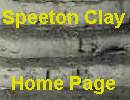
"Friends" I have known
The Speeton Clay is not immediately welcoming. It is possible to visit and collect some fossils - but in order to really get to know your way around the stratigraphy you need a good guide. I have been lucky enough to have several of them and have subsequently met other 'addicts'.
My first introduction to Speeton I think was on a satuday afternoon with my friend Wilf Whitaker (who taught a night class at the Hull technical Colege) - I remember walking or rather running along the beach at dusk in order to catch the last bus home and stopping to hammer huge lumps of pyrite that sparked impressivley in the dark.
Later I went there with keen stratigraphers. Ian Alexander, a technician in the geology Dept at Hull University, and keen collector of Speeton Shrimps and huge uncoiled ammonites. I remember helping Alistair Lomax a research student working on the ostracods, to log parts of the B Beds, and also dig out cliff exposures of the A Beds with the help of Professor John Neale. John's collection of Speeton Clay ostracods is now in the Natural History Museum in London (I think) though there are still some in the teaching collection at Hull University's Geography Dept. and I think his macrofossils are in Hull Museums. And Lynden Emery who had done an MSc part time on the palaeoecology of the Speeton Clay and is an expert on the Gastropods. Lynden's collection is in Hull Museums.
Since then I have met Prof Peter Rawson who researches into Lower Cretaceous ammonites. Dr Simon Mitchell who has a most impressive knowledge and collection of belemnites (he used to live opposite me). Jack Doyle who visits Speeton every month from Hertfordshire, an expert on the belemnites, who's collection is being transferred to the Yorkshire Museum in York.

